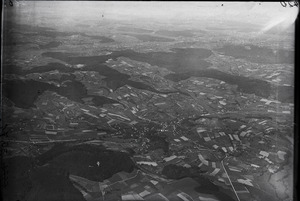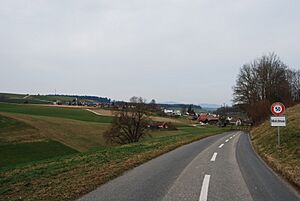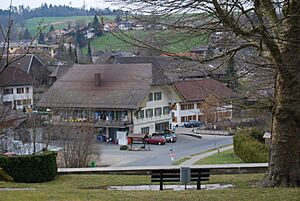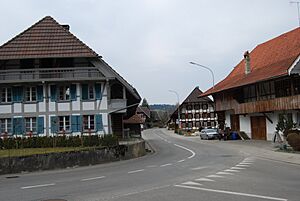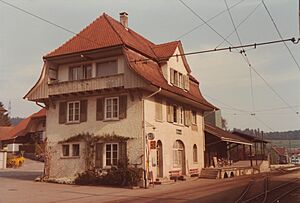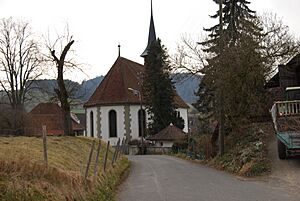Melchnau facts for kids
Quick facts for kids
Melchnau
|
||
|---|---|---|
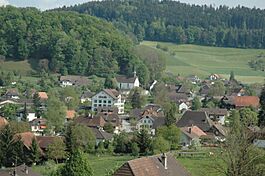 |
||
|
||
| Country | Switzerland | |
| Canton | Bern | |
| District | Oberaargau | |
| Area | ||
| • Total | 10.27 km2 (3.97 sq mi) | |
| Elevation | 481 m (1,578 ft) | |
| Population
(Dec 2020 )
|
||
| • Total | 1,488 | |
| • Density | 144.89/km2 (375.26/sq mi) | |
| Postal code |
4917
|
|
| Surrounded by | Altbüron (LU), Busswil bei Melchnau, Gondiswil, Grossdietwil (LU), Madiswil, Pfaffnau (LU), Reisiswil, Untersteckholz | |
Melchnau is a small town, also called a municipality, located in the Oberaargau area of the canton of Bern in Switzerland. It's a charming place with a long history.
Contents
Melchnau's Rich History
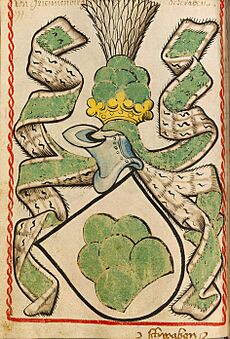
Melchnau celebrated its 900th birthday in the year 2000. The first time the town was written about was around 1100. It was officially mentioned in 1194 as Melchinove.
The Ancient Castles of Melchnau
Above the village, you can find the ruins of three old castles. These are called the Grünenberg-Schnabelburg-Langenstein complex. The Lords of Langenstein were first mentioned in 1194. They helped start St. Urban's Abbey around that time. The Langenstein castle was probably built then too.
Later, the Barons of Grünenberg took over the Langenstein lands. They ruled from Grünenberg Castle. From the 1100s to the 1400s, Grünenberg Castle was a major place for the noble families. These families controlled much of the Oberaargau region. As the family grew and split, a third castle was added.
Melchnau During the Burgdorferkrieg
In 1383–84, during a war called the Burgdorferkrieg, soldiers from Bern attacked and captured the castles and the village. After the war, the lands and castles were given back to the Grünenbergs. However, they had to agree to a treaty with Bern.
The Grünenberg family's power slowly became weaker. In 1444, they sold the lands of Grünenberg castle to Bern. A Bernese vogt (a type of local governor or bailiff) then moved into the castle. In 1452, the last male heir of the Grünenberg family, Wilhelm, passed away. By 1480, the family sold Langenstein castle to Bern as well.
After Bern took over the Grünenberg lands, Melchnau became part of the Bailiwick of Aarwangen. The castles were left empty and slowly turned into ruins. After the French invasion in 1798, Melchnau became part of the Langenthal District. In 1803, it returned to the Aarwangen District.
Changes in Melchnau's Economy
Before the Protestant Reformation, Melchnau was part of the parish of Grossdietwil in the Canton of Lucerne.
In the 1700s and 1800s, farming was still important. But people also started making linen cloth, weaving straw, and making shoes. Shoe making continued until 1960. In the last 100 years, Melchnau has grown from a farming town. It now has many different types of businesses. There are small companies and also light industries, like Lanten Textiles.
In 1917, a small railway line opened between Langenthal and Melchnau. Buses replaced the train service in 1982. The old railway and station are still there. They are sometimes used for special events.
Understanding Melchnau's Geography
Melchnau covers an area of about 10.4 square kilometers (4 square miles). A large part of this land, about 57.5%, is used for farming. Forests cover about 35.2% of the area.
About 7.8% of Melchnau's land has buildings or roads. A very small part, about 0.1%, is rivers or lakes. The rest of the land is not used for farming or building.
Most of the built-up area, 5.0%, is for houses and other buildings. Roads and other transport areas make up 1.8%. In the forested areas, 33.4% is dense forest. Another 1.8% has orchards or small groups of trees.
For farming, 27.5% of the land is used for growing crops. Pastures for animals make up 28.2%. About 1.8% is used for orchards or grapevines. All the water in Melchnau is flowing water, like streams.
Melchnau is located right on the border with the Canton of Lucerne. The municipality includes the main village of Melchnau and many scattered farmhouses.
On December 31, 2009, the old district of Amtsbezirk Aarwangen was closed. On January 1, 2010, Melchnau joined the new Verwaltungskreis Oberaargau district.
Melchnau's Coat of Arms
The blazon (a special description) of Melchnau's municipal coat of arms is: Argent a Mount of Six Coupeaux floatant Vert. This means it shows a green hill with six rounded tops on a silver background.
Melchnau's Population and People
Melchnau has a population of about 1,540 people (as of 2023). In 2010, about 11.1% of the people living there were foreign nationals. Over the past 10 years (2000–2010), the population slightly decreased by 2.8%. This was due to fewer people moving in and more deaths than births.
Languages Spoken in Melchnau
Most people in Melchnau (about 90.7%) speak German as their main language (as of 2000). Serbo-Croatian is the second most common language, spoken by 3.5% of the population. Turkish is third, spoken by 1.8%. A few people also speak French or Italian.
Population Breakdown by Age and Origin
In 2008, about 50.1% of the population was male and 49.9% was female. Most residents are Swiss citizens. In 2000, about 34.8% of the people were born in Melchnau itself. Another 30.6% were born in the same canton (Bern). About 15.5% were born elsewhere in Switzerland, and 12.5% were born outside Switzerland.
As of 2010, children and teenagers (0–19 years old) make up 20.8% of the population. Adults (20–64 years old) make up 58.8%. Seniors (over 64 years old) make up 20.4%.
Family Life in Melchnau
In 2000, there were 654 single people in Melchnau who had never been married. There were 784 married people, 158 widows or widowers, and 73 divorced people.
Also in 2000, there were 161 households with only one person. There were 61 households with five or more people. Most apartments (87.5%) were lived in all the time. A small number were used only part of the year (6.8%) or were empty (5.6%). In 2010, new homes were being built at a rate of 2.6 new units per 1000 residents. In 2011, about 4.51% of homes were empty.
Historical Population Growth
The chart below shows how Melchnau's population has changed over many years:

Important Heritage Sites in Melchnau
The Käserstock and the Stock des Birlihofs are special places in Melchnau. They are listed as Swiss heritage sites of national significance. This means they are very important historical or cultural landmarks.
Melchnau's Economy and Jobs
In 2011, Melchnau had a low unemployment rate of 1.67%. This means most people who wanted jobs had them. In 2008, there were 744 people working in the municipality.
Types of Jobs in Melchnau
- Primary Sector: This includes jobs related to farming, like growing crops or raising animals. In 2008, 111 people worked in this sector, with 38 businesses.
- Secondary Sector: These jobs involve making things, like in factories or construction. 286 people worked in this sector, with 17 businesses.
- Tertiary Sector: This includes jobs that provide services, like shops, hospitals, or schools. 347 people worked in this sector, with 43 businesses.
In 2008, there were 581 full-time equivalent jobs. This means if you add up all the hours worked, it's like 581 people working full-time.
- 65 jobs were in the primary sector (mostly farming).
- 266 jobs were in the secondary sector (85% in manufacturing, 14.7% in construction).
- 250 jobs were in the tertiary sector. This included jobs in sales (28%), transport (4.4%), hotels/restaurants (4.8%), finance (1.2%), science (3.2%), education (8%), and healthcare (44.4%).
Commuting and Transportation
In 2000, 254 workers traveled into Melchnau for their jobs. However, 460 workers traveled out of Melchnau to work elsewhere. This means more people leave Melchnau for work than come in. About 13.2% of working people used public transport to get to work. Most people, 51.4%, used a private car.
Religion in Melchnau
Based on the 2000 census, people in Melchnau follow different religions:
- About 13.1% were Roman Catholic.
- About 68.5% belonged to the Swiss Reformed Church (a Protestant church).
- About 1.92% were members of an Orthodox church.
- About 3.12% belonged to other Christian churches.
- About 6.77% were Islamic.
- A small number were Buddhist (5 people) or Hindu (6 people).
- About 5.15% did not belong to any church, or were agnostic or atheist.
- About 2.28% did not answer the question about their religion.
Education in Melchnau
In Melchnau, about 35.9% of the population has finished non-mandatory upper secondary education. This is like high school or vocational training. About 7.6% have completed higher education, like university or a specialized college.
The School System in Bern Canton
The school system in the Canton of Bern works like this:
- One year of non-required Kindergarten.
- Six years of Primary school.
- Three years of required lower Secondary school. Students are grouped by their abilities.
- After lower Secondary, students can continue their education or start an apprenticeship (on-the-job training).
Student Life in Melchnau Schools
During the 2009–10 school year, 195 students attended classes in Melchnau.
- There were 2 kindergarten classes with 31 students. About 9.7% of these students were not Swiss citizens, and 12.9% spoke a different main language than the classroom language.
- There were 6 primary classes with 107 students. About 11.2% were not Swiss citizens, and 10.3% spoke a different main language.
- There were 3 lower secondary classes with 57 students. About 19.3% were not Swiss citizens, and 31.6% spoke a different main language.
In 2000, 26 students came to Melchnau schools from other towns. At the same time, 80 students from Melchnau went to schools outside the municipality.
See also
 In Spanish: Melchnau para niños
In Spanish: Melchnau para niños





